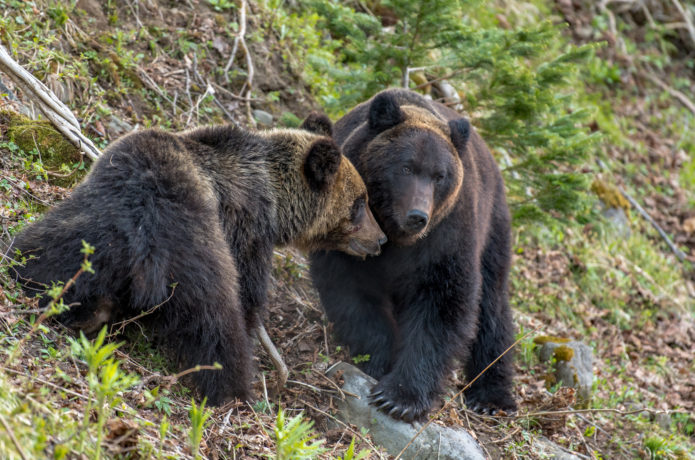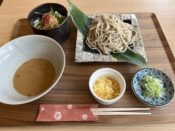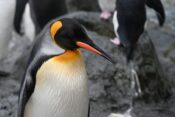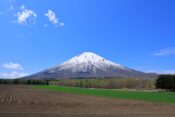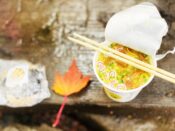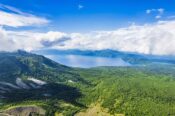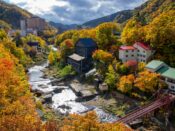ヒグマ(エゾヒグマ)について:北海道の野生の魅力と安全な旅を楽しむためのガイド
北海道の自然を代表する野生動物である**ヒグマ(エゾヒグマ)**は,旅行者にとって非常に魅力的な存在です。その壮大な姿や行動は多くの観光客を惹きつけますが,エゾヒグマは危険な動物でもあります。ここでは,エゾヒグマの生態や観察スポット,旅行者がアクセスするための情報,宿泊やグルメ,アクティビティの紹介に加え,遭遇した際の注意点や事前に知っておくべき予備知識について解説します。(写真:山の斜面で戯れ合うヒグマたち〈北海道知床〉)
エゾヒグマの特徴と生態
エゾヒグマは北海道全域に生息し,体長は約2メートル,体重は300kgを超えることもあります。草食・肉食を含む雑食性の動物であり,特に秋には川で遡上するサケやマスを捕獲する姿が有名です。また,エゾヒグマは冬になると冬眠に入り,春になると再び活発に活動を始めます。
- 季節ごとの行動:春は冬眠から目覚め,食料を探して活発に行動します。夏から秋にかけてはサケやベリーなどを食べて脂肪を蓄え,冬に向けて準備します。秋は特にヒグマ観察のベストシーズンで,川沿いで魚を捕るヒグマの姿を見られることが多いです。
- 冬眠:冬になるとエゾヒグマは冬眠に入り,洞穴などにこもります。この間は食物を摂取せず,体内に蓄えた脂肪で生き延びます。
ヒグマ観察ができる観光スポット
北海道には,エゾヒグマを観察できるスポットがいくつかあります。これらの場所では,ガイド付きツアーや観光船を利用して安全にヒグマの行動を観察することができます。
- 知床半島:世界自然遺産に登録されている知床半島は,エゾヒグマの観察地として最も有名です。知床五湖や知床岬周辺では,ヒグマの自然な行動を見ることができ,特に観光クルーズやガイドツアーが人気です。
- 大雪山国立公園:大雪山国立公園は,広大な自然の中でエゾヒグマの痕跡を探すトレッキングが楽しめます。ヒグマに遭遇することは稀ですが,痕跡や足跡を見つけることができるかもしれません。
- くま牧場(登別・北見):自然の中でヒグマを見るのが不安な方は,登別の「のぼりべつクマ牧場」や北見の「北きつね牧場」を訪れるとよいでしょう。安全にエゾヒグマを観察でき,その生態について学ぶこともできます。
アクセス情報
エゾヒグマの生息地へのアクセスは,レンタカーやツアーの利用が便利です。北海道の主要都市からは交通手段が整備されており,観光地への移動も比較的スムーズに行えます。
- 知床半島へのアクセス:札幌から知床半島までは車で約6〜7時間,女満別空港からは車で約2時間の距離です。観光シーズン中は,知床観光クルーズやガイド付きツアーが運行しているため,安全にヒグマ観察が楽しめます。
- 大雪山国立公園へのアクセス:旭川市から大雪山へは車で約1時間半です。ハイキングやトレッキングの拠点として,宿泊施設や観光案内所が充実しています。
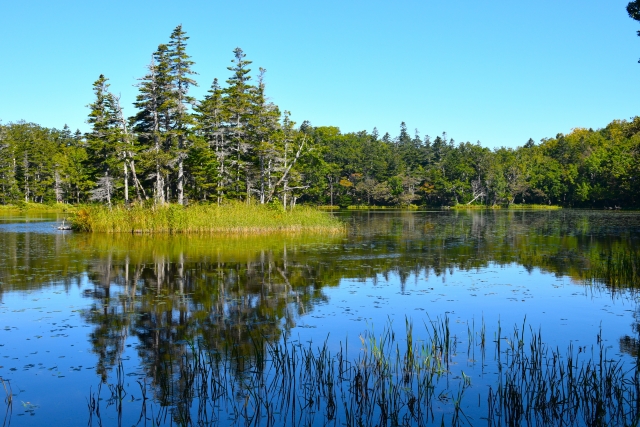
宿泊情報
ヒグマ観察後にリラックスできる宿泊施設も豊富です。自然を満喫できる温泉宿や山小屋は,北海道旅行をより特別なものにしてくれます。
- 知床ウトロ温泉:知床エリアには,温泉宿が多数あり,オホーツク海を望む露天風呂で疲れを癒すことができます。ウトロ温泉は,知床観光の拠点として便利です。
- 大雪山のロッジや山小屋:大雪山国立公園周辺には,自然と一体になれる山小屋やロッジが点在しています。夜には満天の星空を眺めながら,雄大な自然の中でリラックスできます。
グルメ情報
北海道の大自然を楽しんだ後は,地元の食材を使った美味しい料理を堪能しましょう。特に,エゾシカ料理や新鮮な海産物が人気です。
- エゾシカ料理:エゾシカ肉はジビエ料理としてヘルシーで美味しく,ステーキやシチューとして提供されます。道内の多くのレストランで味わうことができます。
- 北海道の海産物:知床や釧路周辺では,サケやホタテ,カニなどの新鮮な海産物が提供されます。秋には,脂の乗ったサケを使った料理が特に人気です。
アクティビティ
ヒグマ観察以外にも,北海道の自然を満喫できるアウトドアアクティビティが豊富です。
- ハイキングとトレッキング:知床や大雪山には,初心者から上級者向けまでのトレッキングコースが整備されています。自然と触れ合いながら,ヒグマを含む多様な野生動物の痕跡を探す楽しさがあります。
- カヌー体験:釧路湿原では,カヌーで静かな水面を進みながら野生動物を観察できます。野鳥やエゾシカ,さらにはヒグマの姿を遠くから見ることができるかもしれません。
ヒグマとの遭遇時の注意点と事前知識
エゾヒグマは魅力的な野生動物ですが,遭遇した場合には危険が伴います。旅行者は自然の中で安全を確保するために,事前に十分な知識を持っておくことが重要です。
- クマよけ対策:ヒグマの生息地に入る際は,クマよけの鈴やホイッスルを持参し,音を立てて自分の存在を知らせましょう。また,食べ物やゴミを自然に放置しないように注意してください。食料の匂いがクマを引き寄せることがあります。
- ヒグマに遭遇した場合:万が一エゾヒグマに遭遇した場合は,背を向けずにゆっくりと後退し,クマとの距離を保ちます。急な動きや大声は避け,クマに興奮を与えないように静かに行動しましょう。
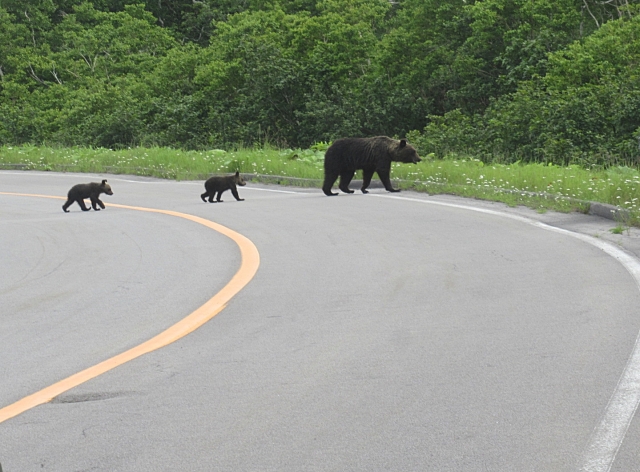
まとめ
エゾヒグマは北海道の雄大な自然を象徴する野生動物です。知床や大雪山など,北海道の豊かな自然の中で安全にヒグマ観察を楽しむことができますが,遭遇時には慎重な行動が必要です。自然と触れ合いながらエゾヒグマの生態を学び,忘れられない北海道の旅を楽しんでください。
Ezo Brown Bear: Hokkaido’s Majestic Wildlife and How to Safely Enjoy Your Journey
The Ezo brown bear is one of Hokkaido’s most iconic wild animals, offering a unique and thrilling opportunity for travelers to witness nature’s grandeur. However, encountering these powerful creatures also requires caution. This article explores the Ezo brown bear’s habitat, observation spots, travel information, accommodation, local cuisine, and activities, along with essential safety tips for encountering bears in the wild.
Ezo Brown Bear: Majestic Wildlife of Hokkaido
The Ezo brown bear is a subspecies of the Eurasian brown bear that is native to Hokkaido. Known for its impressive size and strength, it can grow over 2 meters in length and weigh up to 300 kg or more. These omnivores consume a variety of foods, from berries and plants to fish like salmon and trout, which they are famously known to catch in Hokkaido’s rivers during the autumn season. During the winter, the bears hibernate, living off the fat reserves they accumulate in the warmer months.
- Seasonal Behavior: In spring, Ezo brown bears emerge from hibernation and begin foraging for food, becoming most active in summer and fall. Autumn is the prime season for observing bears as they prepare for winter by feasting on fish and berries.
- Hibernation Habits: Ezo brown bears hibernate through the cold winter months in dens. They rely on the fat they store during the summer and fall to survive the winter months without food.
Where to Observe Ezo Brown Bears in Hokkaido
There are several well-established areas where visitors can safely observe Ezo brown bears. These areas often offer guided tours, ensuring a safe and enriching wildlife experience.
- Shiretoko Peninsula: As a UNESCO World Heritage Site, the Shiretoko Peninsula is one of the most famous places for observing Ezo brown bears. Areas like the Shiretoko Five Lakes and Cape Shiretoko offer excellent opportunities for bear sightings. Many guided boat tours and walking tours provide safe ways to observe the bears in their natural habitat.
- Daisetsuzan National Park: In central Hokkaido, Daisetsuzan National Park offers a rugged and beautiful landscape where hikers can find traces of bear activity. Although encounters are rare, spotting bear tracks or other signs of their presence adds to the experience of trekking through this vast wilderness.
- Bear Parks (Noboribetsu and Kitami): For those who prefer a safer, controlled environment, Noboribetsu Bear Park and Kitami Fox Village offer opportunities to see Ezo brown bears up close. These facilities provide educational information about the bears and allow visitors to observe them safely from a distance.
How to Access Ezo Brown Bear Areas
Access to areas where Ezo brown bears are commonly observed is convenient, especially with rental cars or organized tours. Visitors from Hokkaido’s major cities will find it relatively easy to plan trips to these remote areas.
- Getting to the Shiretoko Peninsula: From Sapporo, it takes about 6-7 hours by car to reach the Shiretoko Peninsula, or around 2 hours from Memanbetsu Airport. Many travelers opt for guided tours or cruise ships to safely enjoy bear-watching without worrying about transportation.
- Getting to Daisetsuzan National Park: Daisetsuzan is about 1.5 hours from Asahikawa by car, making it a popular destination for those who enjoy hiking and nature activities. Visitors can explore various trails that offer insights into the park’s diverse wildlife.
Where to Stay Near Ezo Brown Bear Areas
After a day of observing Ezo brown bears, nothing beats relaxing in one of Hokkaido’s renowned accommodations. From rustic lodges to luxurious hot spring resorts, visitors have plenty of options for a comfortable stay.
- Utoro Hot Springs (Shiretoko): In the Shiretoko area, the Utoro Hot Springs are a popular option for relaxation. Many hot spring resorts offer stunning views of the Okhotsk Sea, providing a perfect setting for unwinding after a day of bear watching.
- Mountain Lodges and Cabins (Daisetsuzan): Daisetsuzan National Park offers various mountain lodges and nature-based accommodations, ideal for those looking to immerse themselves in Hokkaido’s wilderness. These lodges offer basic but comfortable accommodations, often surrounded by beautiful landscapes.
Local Cuisine
Hokkaido is famous for its fresh ingredients and unique flavors. After a long day of exploring the wilderness, visitors can enjoy the local cuisine, which includes fresh seafood and game meats.
- Ezo Deer Dishes: Ezo deer meat is lean, nutritious, and often served as steaks or stews in many Hokkaido restaurants. It’s a healthy and delicious way to experience local flavors.
- Hokkaido Seafood: In areas like Shiretoko and Kushiro, fresh seafood is a must-try. Salmon, crab, and scallops are among the most popular dishes, with autumn being the prime season for salmon.
Activities Beyond Bear Watching
In addition to observing Ezo brown bears, Hokkaido offers numerous outdoor activities that allow travelers to fully experience its pristine nature.
- Hiking and Trekking: Shiretoko and Daisetsuzan boast some of Hokkaido’s best hiking and trekking trails, offering spectacular views of mountains, forests, and coastlines. Visitors can enjoy these trails while keeping an eye out for wildlife, including brown bears and deer.
- Canoeing: In Kushiro Marsh, canoeing is a popular way to experience the natural beauty of the wetland. Gliding across calm waters, visitors might spot deer, birds, and, in rare instances, bears from a safe distance.
Essential Bear Safety Tips
While observing Ezo brown bears is an unforgettable experience, safety is paramount. Travelers should be well-prepared and follow strict safety guidelines to minimize the risk of dangerous encounters.
- Bear Repellent Measures: Always carry bear bells or whistles to alert bears to your presence. Make noise while hiking, especially in dense forests or near rivers, where bears are more likely to be found.
- Avoid Attracting Bears: Never leave food or trash unattended in bear habitats, as the smell can attract them. If you’re camping or spending extended time in the wilderness, store food securely and dispose of waste properly.
- In Case of a Bear Encounter: If you encounter a bear, remain calm and avoid sudden movements. Do not run. Back away slowly while maintaining eye contact and speaking in a calm, steady voice. If the bear approaches, try to appear larger by raising your arms or a backpack.
Conclusion
The Ezo brown bear is a symbol of Hokkaido’s vast and untamed wilderness. Observing these majestic creatures in their natural habitat is an unforgettable experience that connects visitors with nature. Whether you visit the Shiretoko Peninsula or explore the trails of Daisetsuzan National Park, you’ll gain a deeper appreciation for the rich wildlife and landscapes of Hokkaido. Remember, safety comes first when traveling in bear country, so prepare accordingly and enjoy the adventure!
